

CarExpert.com.au
Model range deep-dive: Mahindra's SUV family
4 Days Ago
The Iveco Daily offers a payload that dual-cab ute owners dream of, and you can still tow 3.5 tonnes – is it worth the price tag?
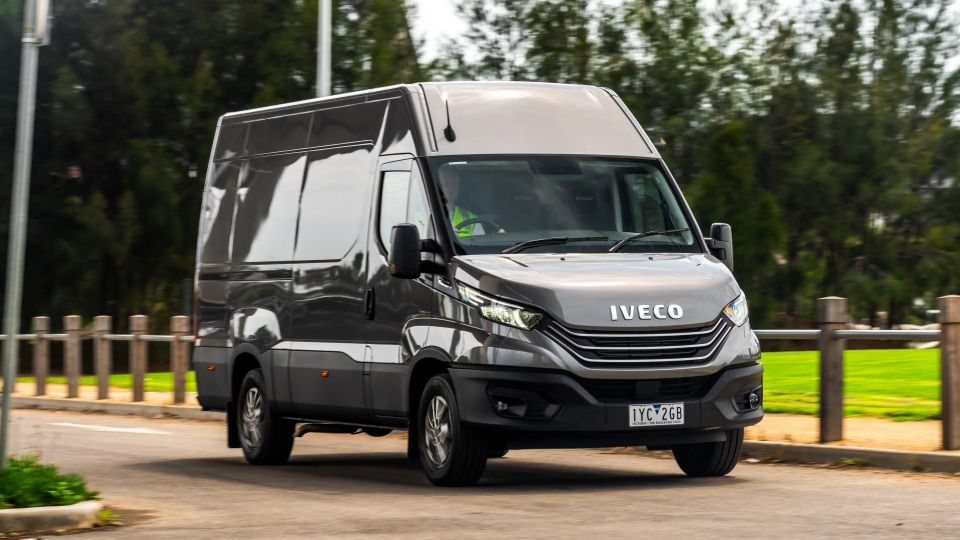
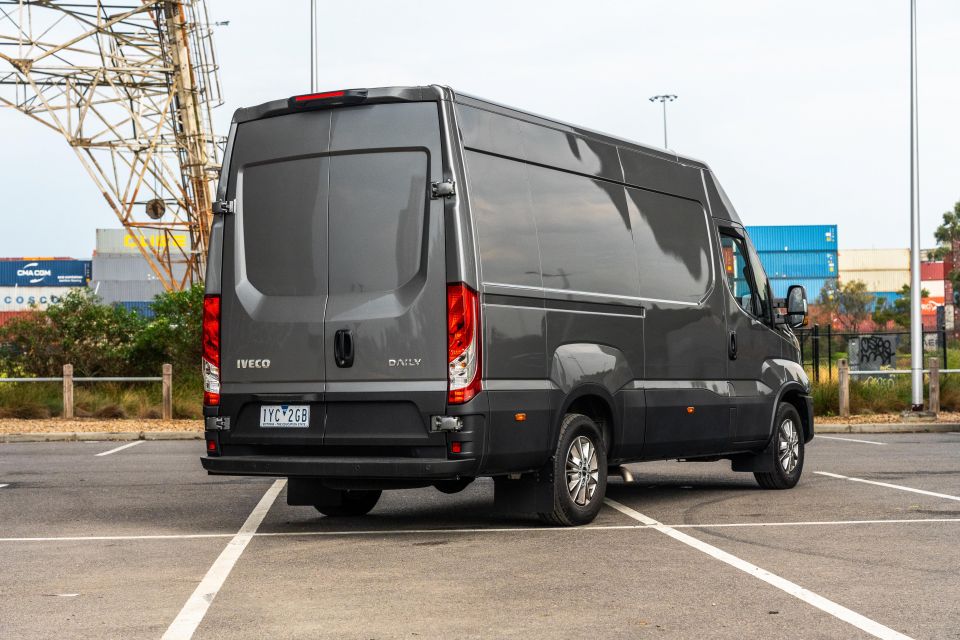

Quickly see how this car stacks up against its competition. Select any benchmark to see more details.
Where expert car reviews meet expert car buying – CarExpert gives you trusted advice, personalised service and real savings on your next new car.
This isn’t a type of vehicle we review very often here at CarExpert, but the Iveco Daily E6 in certain configurations, including this one, can still be driven with a regular car licence.

On test here is a 2024 Iveco Daily E6 Van 4×2 with 12 cubic metres of rear cargo capacity. Sure this isn’t an outstanding figure in van terms, but compared to dual-cab utes this is considerably more cargo capacity.
The Daily E6 Van has a braked towing capacity of 3500kg like the majority of dual-cab utes, however it has a payload of more than 1500kg. This is considerably more than what dual-cab utes like the Ford Ranger and Toyota HiLux offer.
The van can also be loaded all the way up to the maximum payload and still tow a 3500kg braked trailer. This certainly isn’t something all dual-cab utes can boast.
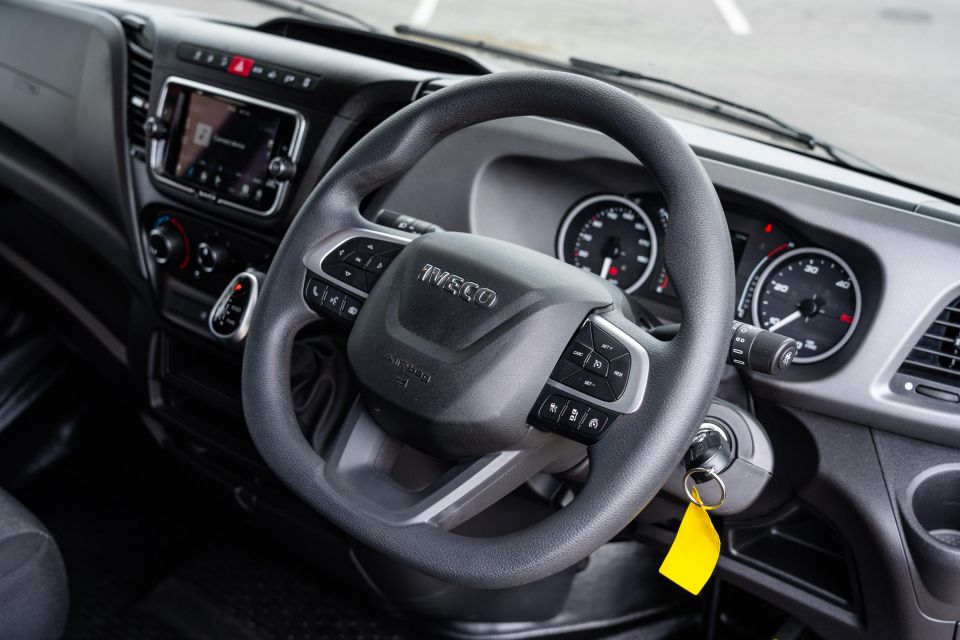
Iveco claims the Daily E6 Van is ideal for rental fleets, tradespeople, couriers, emergency services, as well as a campervan, among other use cases requiring a high payload and towing figure.
Is this vehicle worth considering in a ute-dominated market? Read along to find out.
As a base, the 2024 Iveco Daily E6 Van 4×2 starts off at $69,483 before on-road costs for the 35S Van with a rear cargo area measuring 7m.
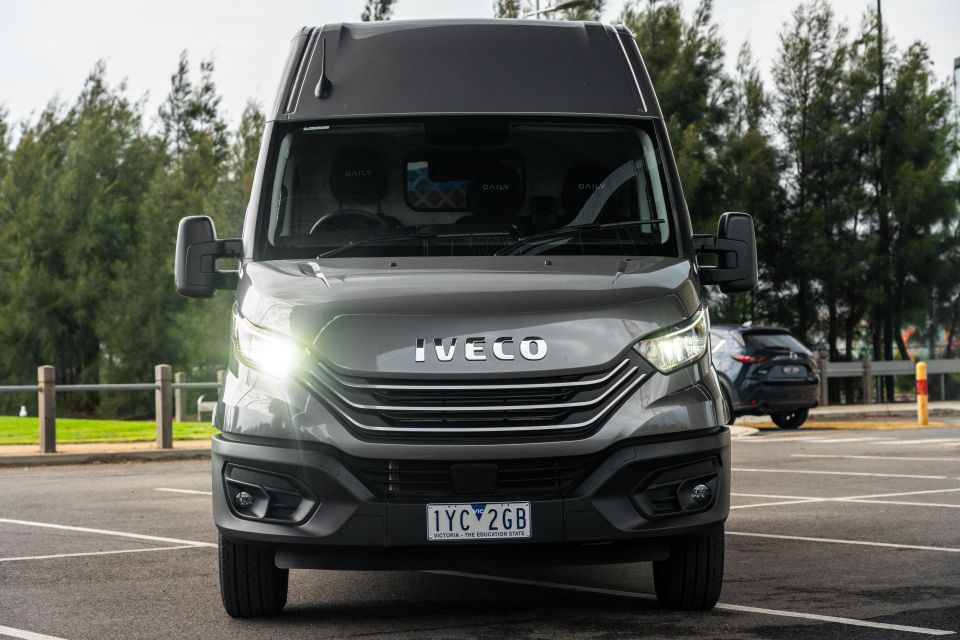
The Iveco Daily E6 35S Van, as tested here, with the larger optional 12-cubic-metre rear cargo area.
It was also equipped with the optional Hi-Business ($1760) and Hi-Tech Packs ($2750), optional 16-inch alloy wheels ($495), optional ZF-sourced eight-speed automatic transmission ($4565), as well as metallic paint ($4151).
Including all the optional extras fitted, out test van cost $90,437 before on-roads costs.
This is notably more expensive than a number of similarly sized Fiat Ducato LWB MR Van ($60,022), Ford Transit 350E automatic ($63,490), LDV Deliver 9 LWB HR Van ($51,042 D/A), Mercedes-Benz Sprinter 415CDI LWB ($80,804), Renault Master LWB ($59,050 D/A), and Volkswagen Crafter 35 TDI340 LWB ($65,030).
Walking up to the Iveco Daily it clearly has some presence. It’s essentially a large box on wheels and that can be a little intimidating when you need to climb multiple steps to get into the driver’s seat.
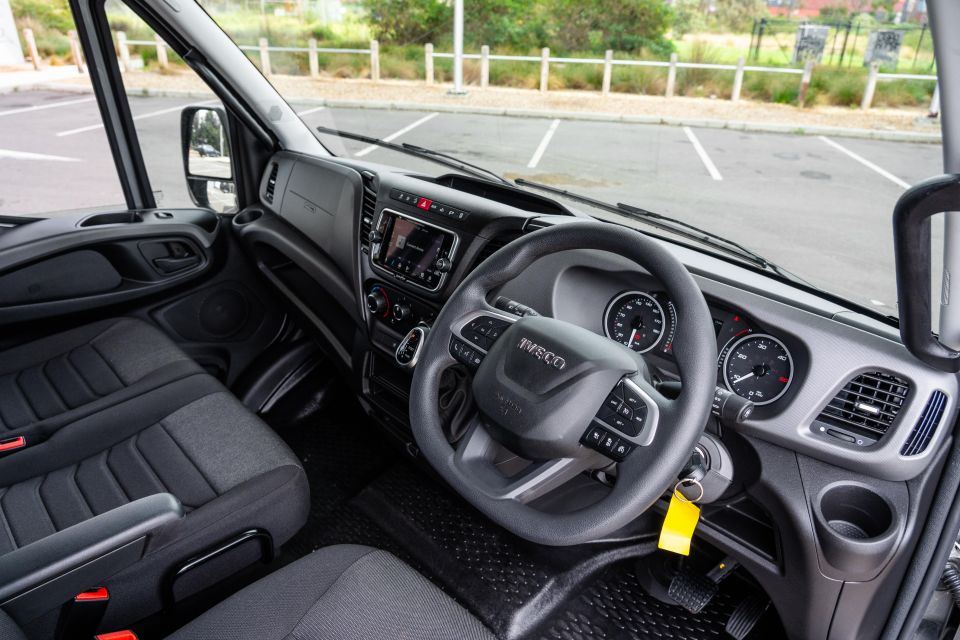
Thankfully there are some hefty grab handles to make the climb up into the van a touch easier.
As standard the Daily comes with a three-seat configuration, including a two-person bench on the passenger side. All the seats are finished in a black fabric upholstery with an inoffensive design. There’s also ‘Daily’ embroidered onto the headrests, which is a neat touch.
Just like a bus or a truck, the driver’s seat is suspended. This means the seat can iron lumps and bumps that are transmitted into the van’s cabin. You’re able to dial up or down the amount of rebound force the seat provides using a dial.
All the driver’s seat adjustments are manual, which to be expected in this kind of vehicle. Surprisingly however, the driver’s seat is heated. This is feature that’s rare in vehicles with fabric seats and it comes in handy on cool Melbourne mornings.
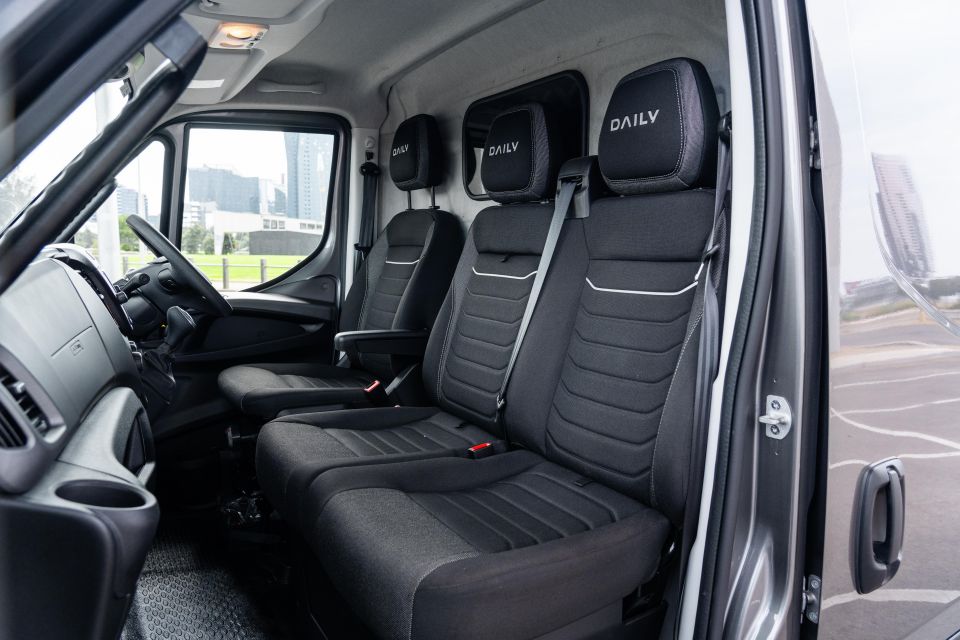
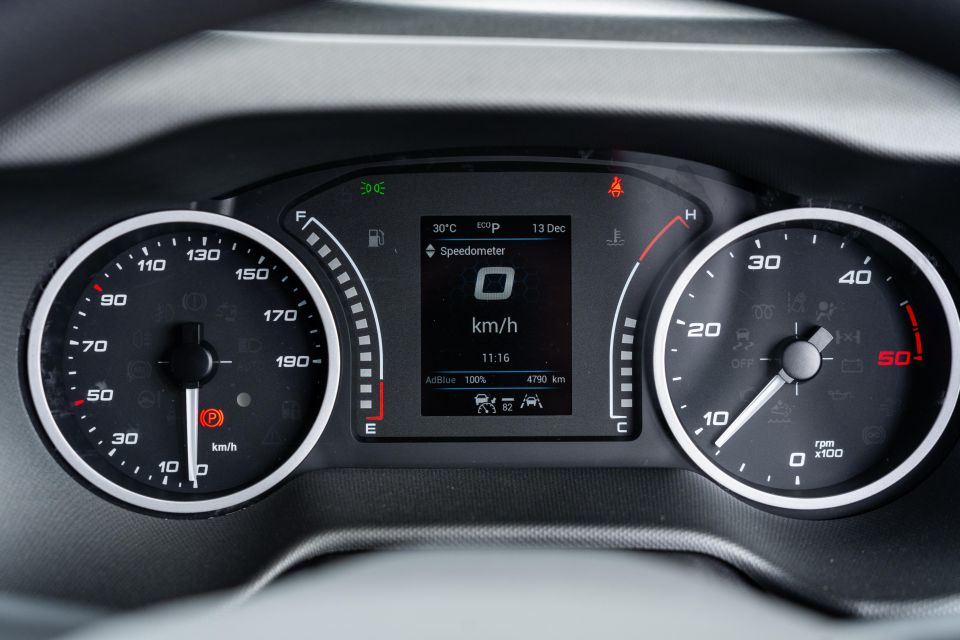
The driver’s seat itself is comfortable and supportive enough for sitting over long periods of time, though you can’t escape the fact you’re sitting up extremely high. If you’re not used to sitting up this high in a vehicle it can take some time to adjust.
Ahead of the driver is a plastic steering wheel that has both tilt and reach adjustment. You can option a leather-wrapped steering wheel as part of the optional Hi-Comfort Pack. It wasn’t equipped to our tester however.
Steering wheel reach adjustment is rare in these kinds of commercial vehicles. It’s also crucial for people with longer legs, like myself.
It appears Iveco has sourced some of the Daily’s interior hardware from somewhere within the Stellantis group as its steering wheel buttons, including the ones mounted behind the steering wheel for audio controls, seem to be look and feel like the ones in a Jeep.
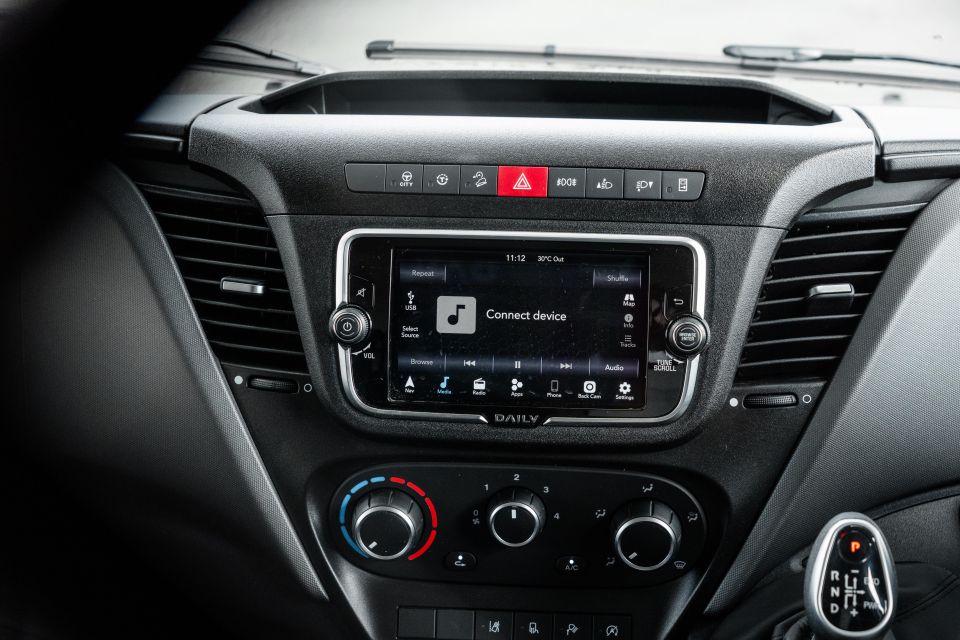
This extends to the plasticky and cheap-feeling indicator and wiper stalks that also feel like they are from a Jeep.
Behind the steering wheel are a set of clear analogue dials for the revs and speedometer. These dials sandwich a 3.5-inch digital instrument cluster that’s clear enough and has a basic interface.
Drivers are able to cycle through a wide range of informative pages on the digital instrument cluster using the steering wheel buttons. Page views include a digital speedometer readout, trip computer, fuel economy, vehicle information, among others. Frustratingly only one page can be viewed at a time.
Moving across there’s a touchscreen infotainment system that seems to be reskinned version of Stellantis’ UConnect infotainment system. Although Iveco doesn’t quote an official size for the touchscreen, it’s safe to say it’s on the smaller side. It’s also a bit of stretch to reach from the driver’s seat.

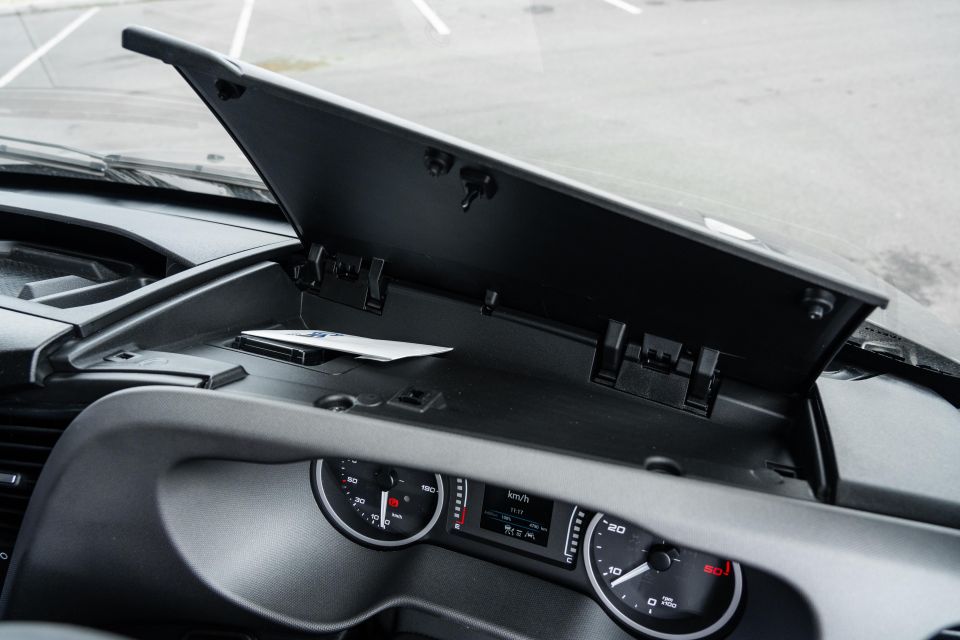
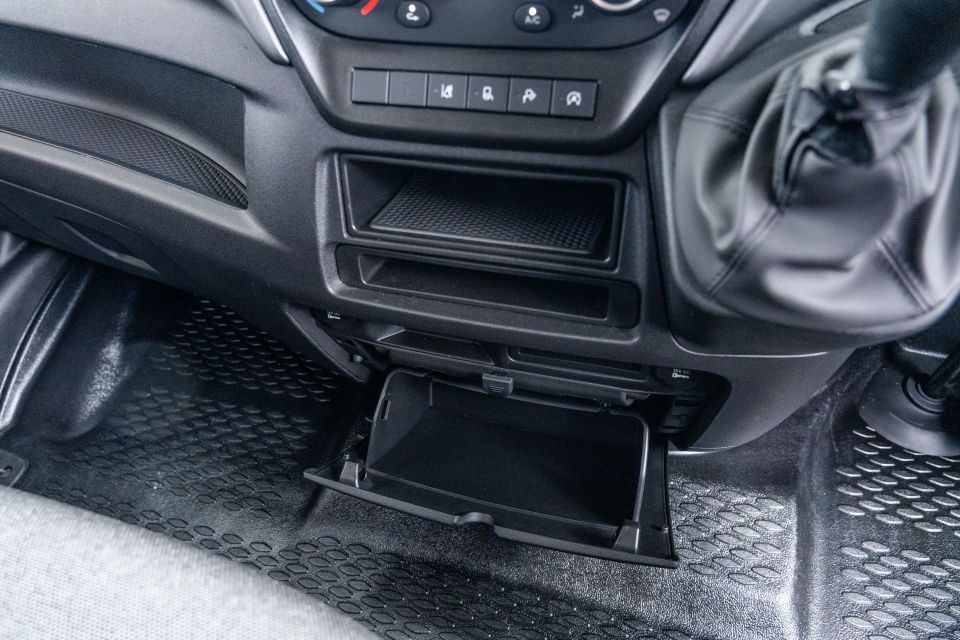
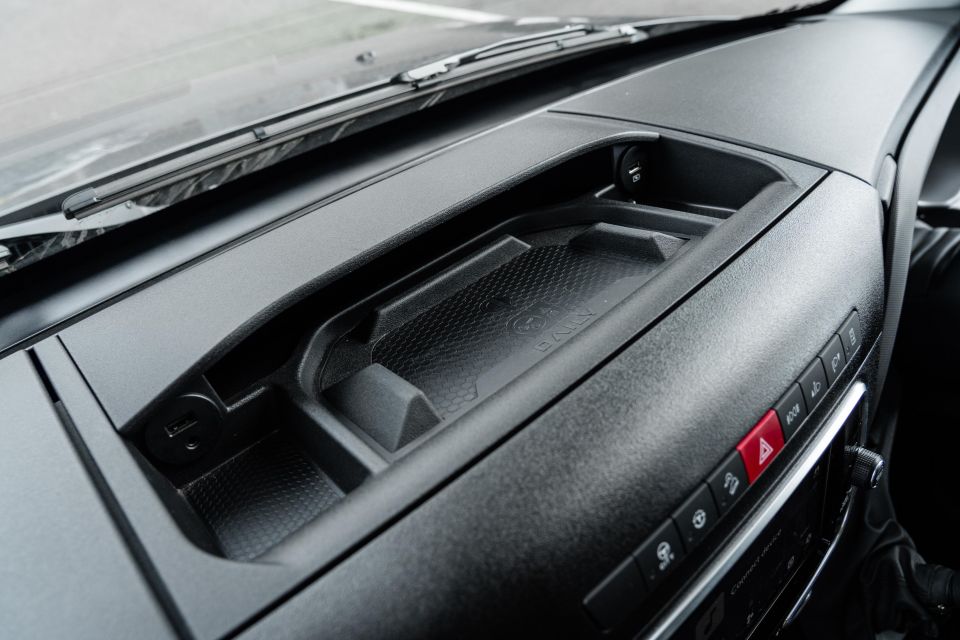
The touchscreen appears to have enough processing power, which means it boots up quickly upon startup and new pages open snappily.
Wired Apple CarPlay and Android Auto are offered as standard. With my iPhone 15 Pro Max plugged in using a USB cable, Apple CarPlay worked fine but would strangely glitch when playing a song every now and then.
This was one of the few times I experienced glitches with wired smartphone mirroring. Typically this kind of connection is rock solid unless the USB cable starts to become faulty.
Our tester came equipped with the optional Hi-Business Pack which adds TomTom-based satellite navigation to the touchscreen infotainment system, as well as LED headlights, fog lights, and a wireless phone charger.
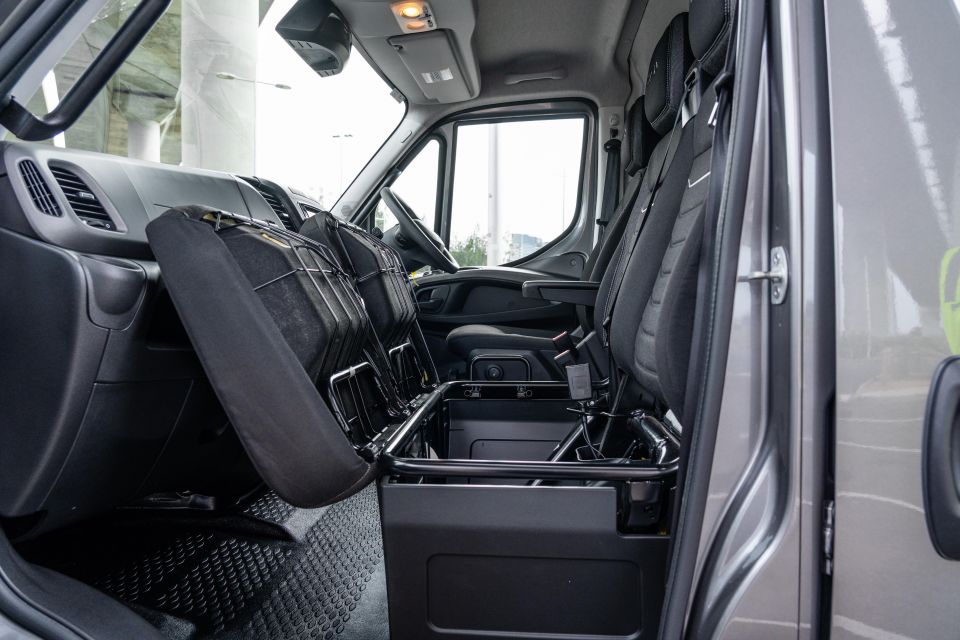
The latter of these is mounted on top of the dashboard in a special storage space, which I believe is an ideal position for it. Its location means it won’t slip and slide around if you brake, accelerate, or turn around a corner.
Further down the Daily comes as standard with manual air-conditioning. Climate control is available as part of the optional Hi-Comfort Pack that wasn’t fitted to our tester.
Like a number of commercial vans, the Iveco Daily E6 Van has plenty of storage options. There’s an overhead console with a storage shelf, tradie-style dashboard cupholders and gloveboxes galore.
As noted above, there’s a two-person bench seat on the passenger side. The middle seat has a fold-down armrest with a built-in clipboard, while both passenger seat bases can also fold upwards to reveal more storage space.
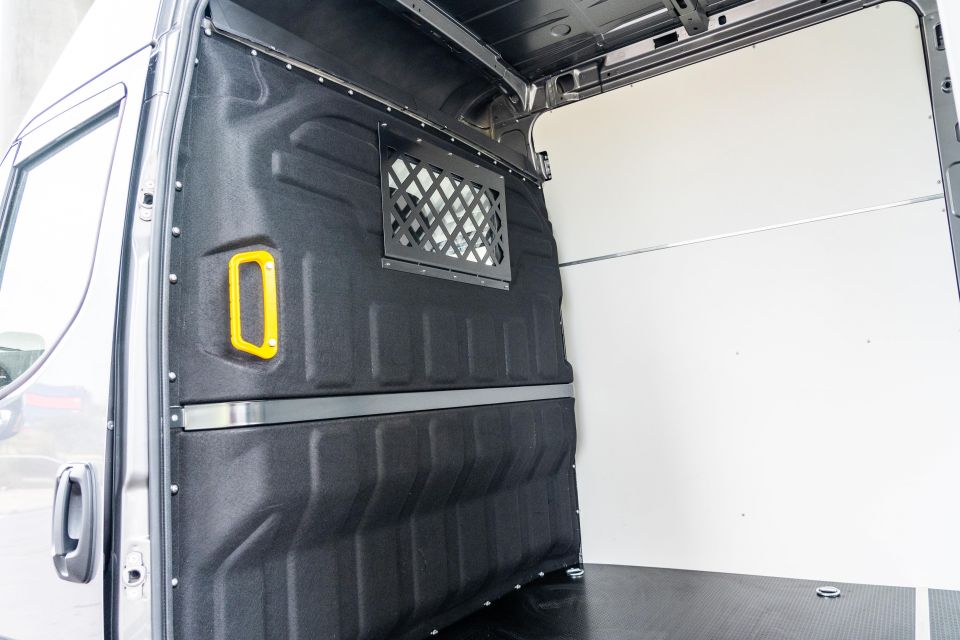
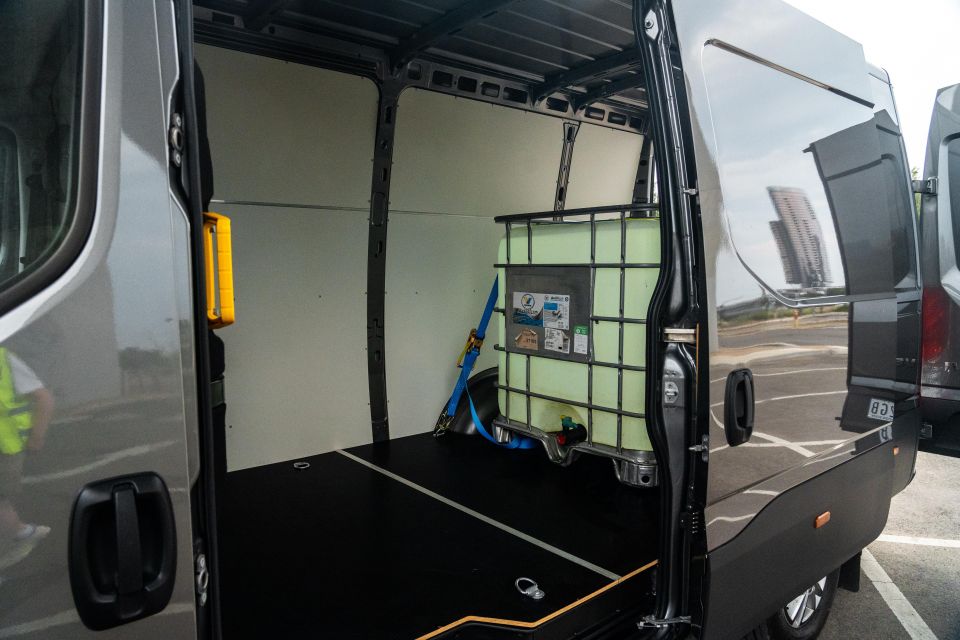
Looking around the Daily’s interior there are a lot of dark finishes and most of them are harder plastics. This is to be expected given the commercial focus of this type of vehicle and how it’s meant to last in the long run.
Moving around to the side of the van there’s a single sliding door on the passenger side. This makes a lot of sense in right-hand drive markets like Australia because the door is on the kerbside.
You’re able to option a second sliding side door on the driver’s side, but this wasn’t equipped to our tester.
At the rear there are dual rear barn duals that can open at a maximum of 270 degrees. The doors also have a stops at 90 degrees.
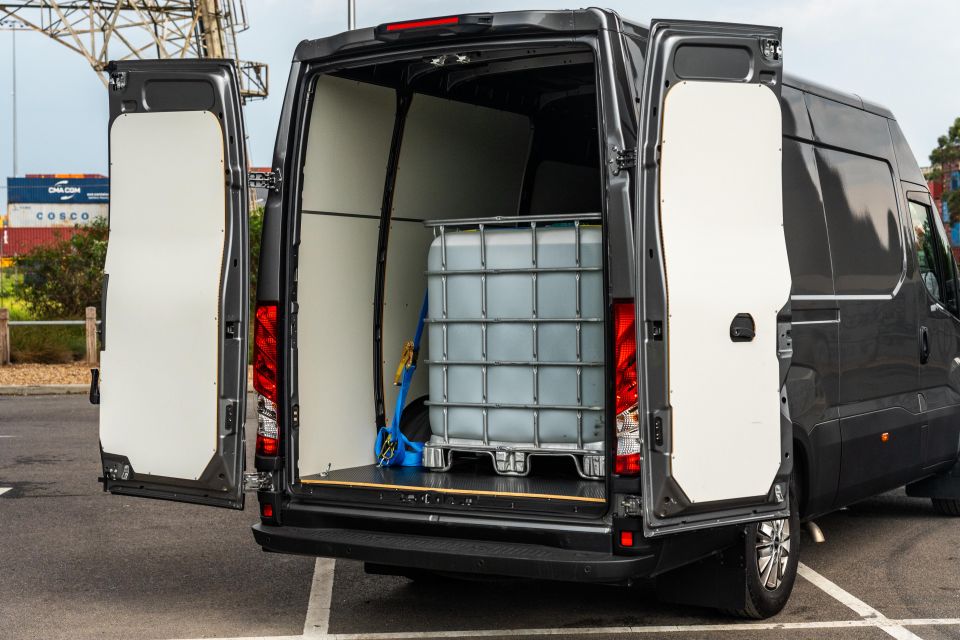
There are large steps at both the side and rear doors to make getting into the rear cargo compartment easier, as well as a handy grab handles.
Our tester had a rear compartment capacity of 12 cubic metres. It measures in at 3540mm long, 1740mm wide, and 1900mm tall.
There isn’t much in terms of amenities in the rear cargo area apart from tie-down points for whatever you choose to load in there.
The Iveco Daily E6 Van is available in a countless number of body style and powertrain configurations.
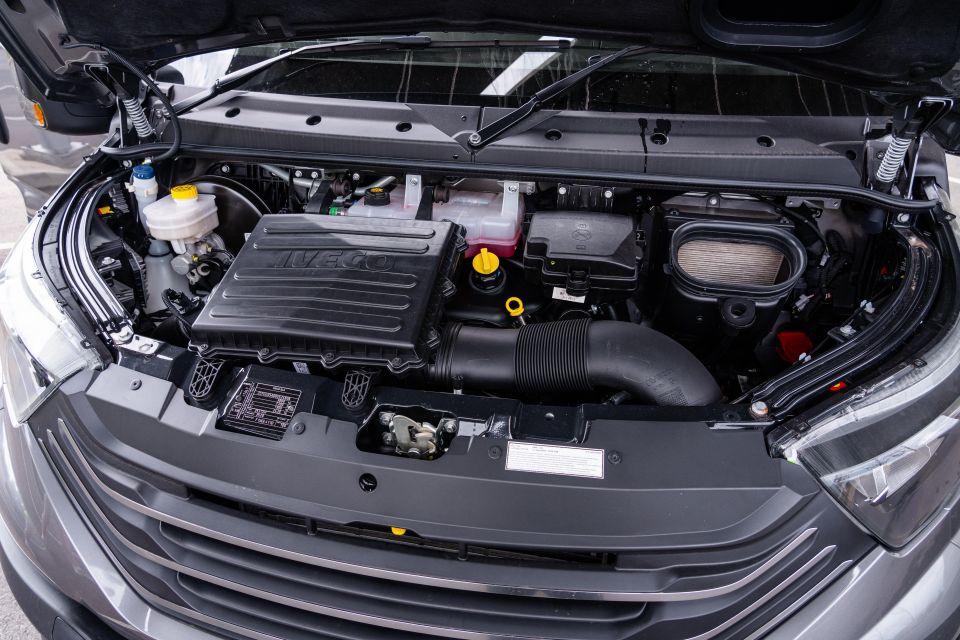
The vehicle on test here is towards the smaller end in the range and is technically called the Daily E6 35S Van with a 12 cubic metre van box body. It can be driven on a regular car licence in Australia.
There are a number of other 35S variants with different cargo capacities, as well as heavier-duty 50C and 70C variants available in a wealth of configurations, including cab-chassis and 4×4 versions. Some of the heavier-duty variants require a Light Rigid (LR) licence as their gross vehicle masses (GVMs) exceed 4.5 tonnes.
Our tester was fitted with a 2.3-litre four-cylinder turbo-diesel engine with 100kW of power and 350Nm of torque, which is the smallest and least powerful engine offered in the Daily. More powerful 3.0-litre four-cylinder turbo-diesel engines with 132kW/430Nm and 155kW/470Nm are available.
As standard the Daily comes equipped with a six-speed manual transmission, but a ZF-sourced eight-speed automatic transmission is available as an optional extra – this was equipped to our tester.
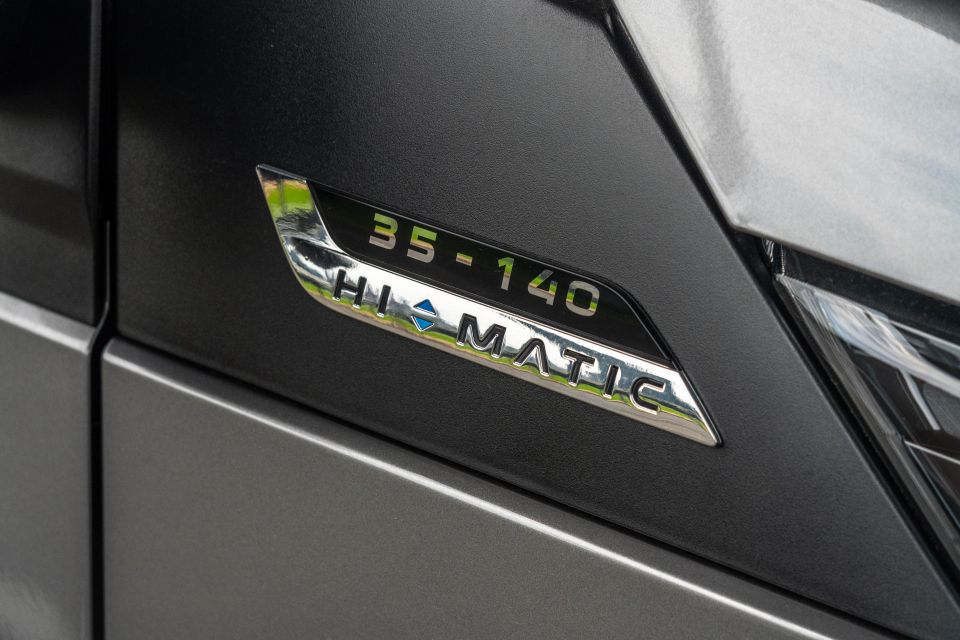
| Model | Iveco Daily E6 35S Van |
|---|---|
| Engine | 2.3-litre 4cyl turbo-diesel |
| Power | 100kW |
| Torque | 350Nm |
| Transmission | 8-speed automatic transmission |
| Driven Wheels | Rear-wheel drive |
| Weight | 2279kg (kerb) |
| Payload | 1521kg |
| Braked towing capacity | 3500kg |
| Gross vehicle mass | 3800kg |
| Gross combination mass | 7300kg |
| Fuel economy (claimed) | N/A |
| Fuel economy (observed w/ 900kg payload) | 10.8L/100km (100km mixed driving) |
| Fuel tank | 100 litres |
| AdBlue tank | 20 litres |
It’s worth flagging we drove this van with a pallet of AdBlue strapped down in the rear. It weighed around 900kg, which was used to simulate a real-world driving scenario.
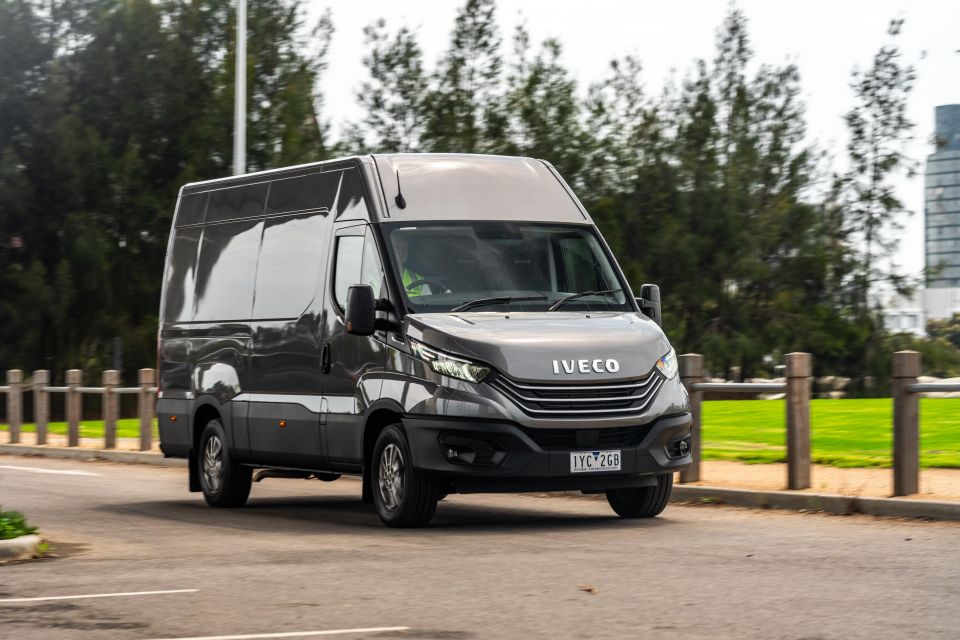
Where expert car reviews meet expert car buying – CarExpert gives you trusted advice, personalised service and real savings on your next new car.
Starting up the Iveco Daily van you need to turn a physical key to fire the 2.3-litre four-cylinder turbo-diesel engine to life. It’s a commercial vehicle after all, so don’t expect anything too fancy like proximity entry and push-button start.
Initially there’s a bit of clatter that comes from the turbo-diesel engine, but that’s to be expected. Thankfully once the engine warms up the noise dies down a little and the vibrations become less harsh.
When you go to set off you first need to understand how the Daily’s gear selector works. It’s a strange-looking unit, but operates fundamentally like the Toyota Prius’ and after a while becomes very intuitive.
You push the gear selector across to the left for neutral, then either up or down for reverse or drive. Park is selected by pressing a button at the top of the gear selector. In its default position you can also push up or down when driving to select the ‘Eco’ or ‘Pwr’ drive modes. ‘Eco’ is the standard drive mode.
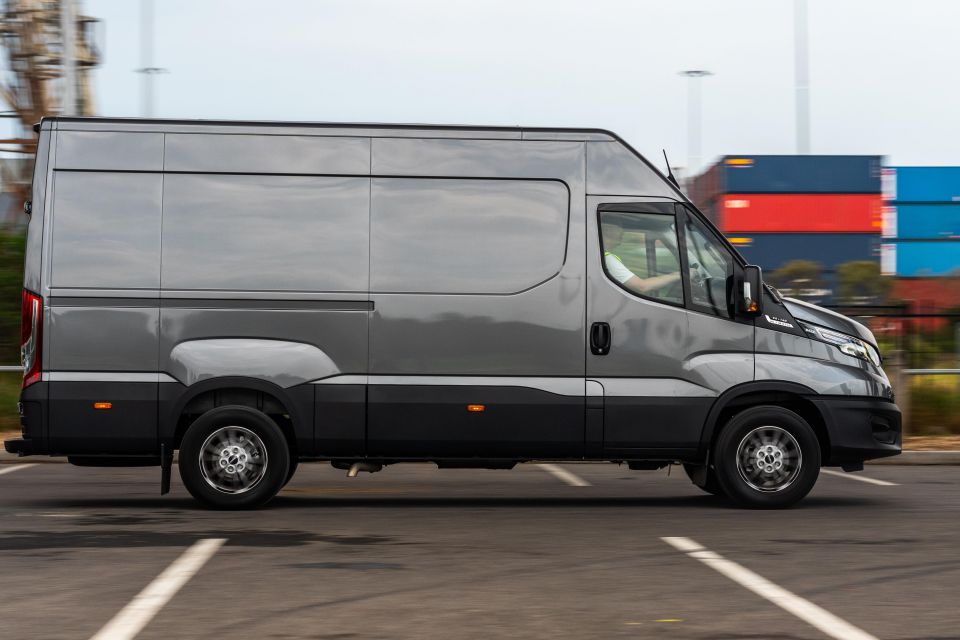
Despite the modest outputs of 100kW and 350Nm, the Daily Van is still powerful enough to keep up with urban traffic. Don’t be expecting to pull away from cars however, if you’re that way inclined.
What the Daily lacks in outright performance it makes up for with an incredibly smooth-shifting automatic transmission. The ZF-sourced unit is optional and I can’t recommend it more – gear shifts are seamless and surprisingly quick given it’s a commercial vehicle.
Although it may initially seem a little overwhelming to be driving a vehicle so unwieldy – it was too tall to fit into our office carpark – the Daily’s light steering makes it feel smaller than it is.
There’s even a function you can turn on that makes the steering even lighter. This comes in handy when you’re needing to turn tightly and quickly in low-speed scenarios, including tight urban streets and three-point turns.
Even though the steering can be made super light it doesn’t properly disguise how large the van is. Our tester had a kerb-to-kerb turning circle of 12 metres.
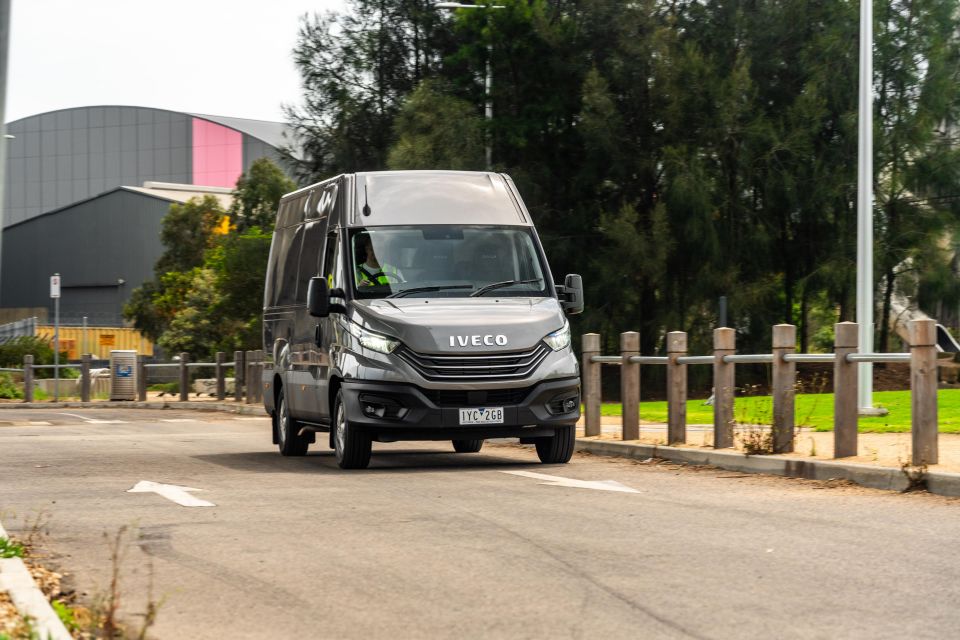
As standard the Iveco Daily E6 Van comes with reverse camera and rear parking sensors. It also has a reversing buzzer which allows me to fulfil my heavy-duty truck driving fantasy (see the images of me wearing the fluorescent jacket).
Something that took me a while to get used to driving the Daily was the lack of a rear-view mirror. There’s no need for one because of the bulkhead separating the cabin and rear cargo sections.
I kept on looking in the direction of where a rear-view mirror would typically be when I first set out on the road, but after a while I got used to it not being there.
What the Daily has instead of a proper rear-view mirror is really large side mirrors with regular and convex mirror sections. These don’t completely make up for the lack of a rear-view mirror in terms of visibility, but it definitely helps make driving a vehicle this large feel just a bit easier.
Something that would be handy in the Daily however is blind-spot monitoring. The van is massive and sometimes it’s hard to gauge how far ahead of a car you are before merging into a lane.
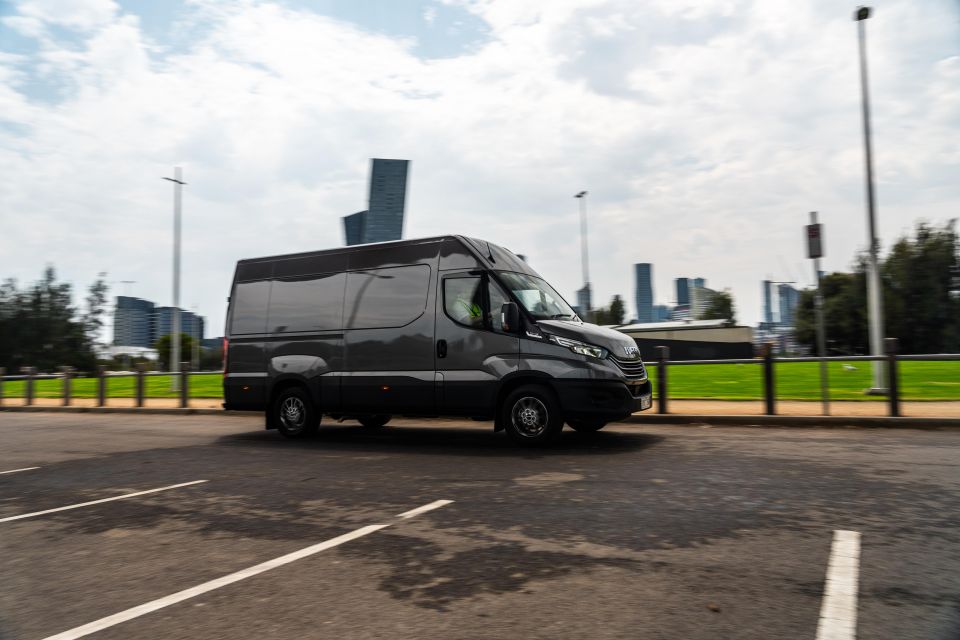
Around town the Daily’s suspension is really compliant and settled. It’s able to deals with speed bumps like a champ.
I’m putting this compliant suspension down to having the 900kg of payload over the rear axle. Leaf-sprung rear suspension setups in commercial vehicles are typically really firm and harsh when unladen.
There’s also the suspended driver’s seat that can iron out the harsher lumps and bumps that are transmitted into the cabin. If you’ve got it dialled back however the seat can get bouncy however, which can make the driving experience a little nauseating.
Building up speed in the Daily E6 Van is when the limits of the 2.3-litre four-cylinder turbo-diesel engine start to present themselves. The van isn’t overtly slow by any means, but it’s also not very quick.
You really need to plan out your overtaking manoeuvres because if you’re not careful you’ll be caught out.
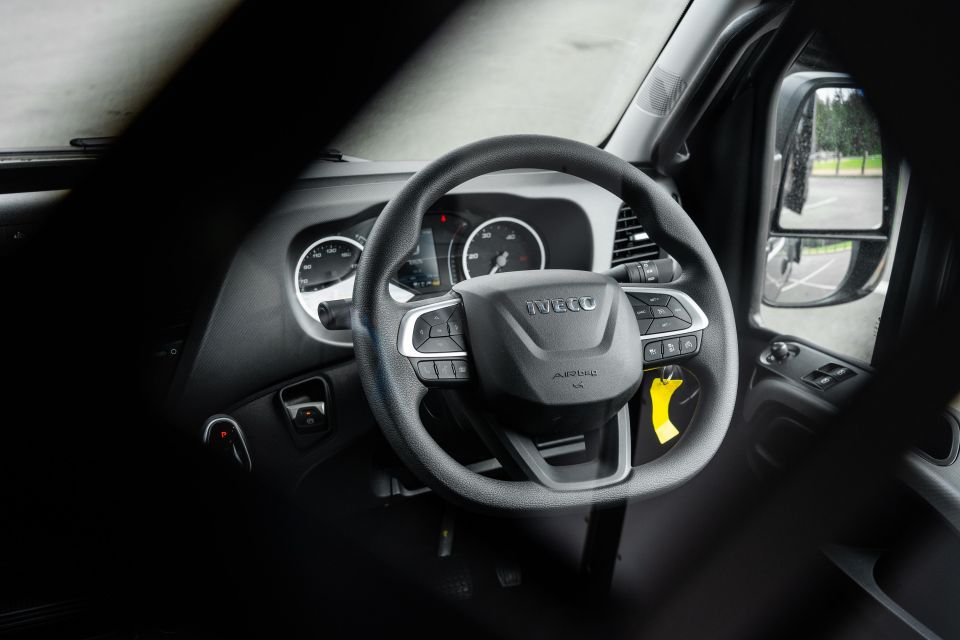
When you really punch the van’s accelerator it doesn’t rev all the way out to redline. For reference, peak power is delivered at 3600rpm and peak torque is delivered at 1500rpm.
Once you’re at highway speeds the Daily E6 Van finds a comfortable groove and keeps the revs down low. If required, the transmission will willingly kick down a couple of gears to get things moving a bit quicker.
Even at highway speeds the van still feels really big and almost truck-like. It takes up almost the entire lane and I found I was constantly making small steering inputs to keep it going straight.
On the safety front, the entire Iveco Daily E6 range comes with adaptive cruise control. When turned on it works seamlessly and exactly how you think it should.
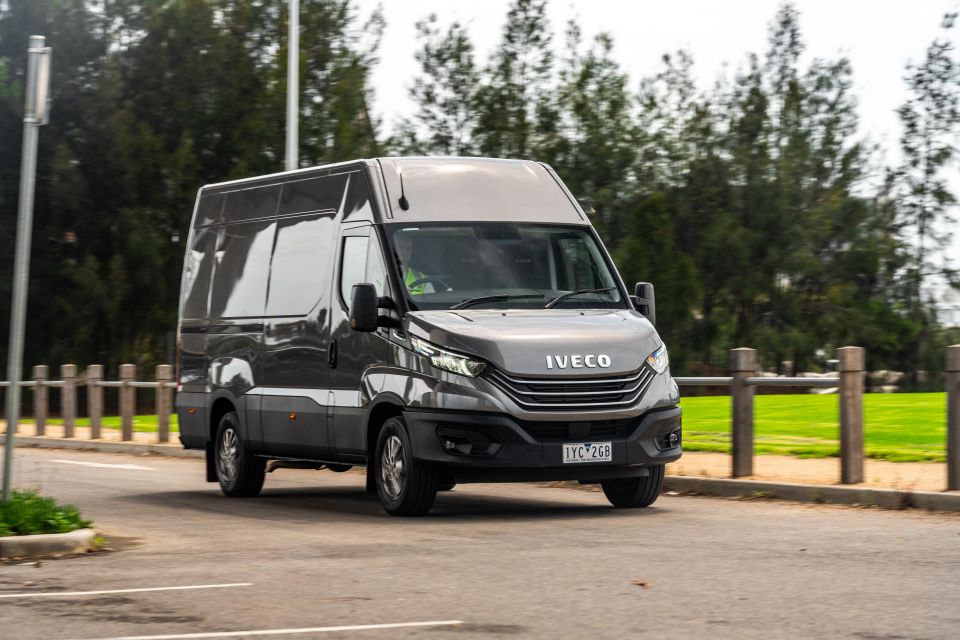
The optional Hi-Technology Pack also adds a City Brake function which prefills the braking system for a faster response if it detects an imminent collision.
Other safety features included in the Hi-Technology Pack includes Queue Assist, lane departure warning and lane keep assist.
The latter of these functions largely keeps you centred in the lane, though it feels like it tugs at the wheel a bit too much. I preferred to switch it off when driving.
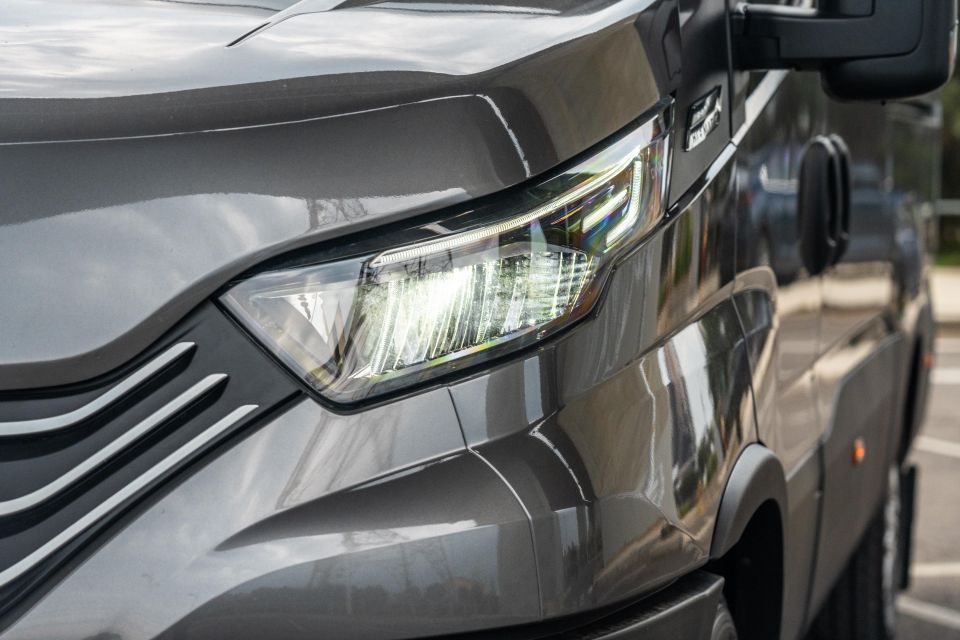

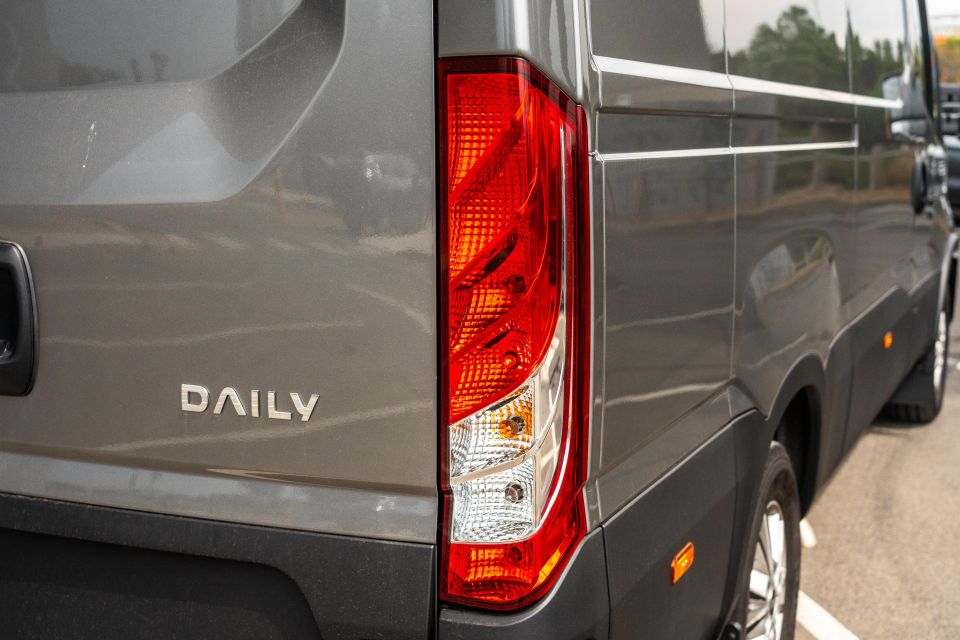

Iveco Daily E6 35S Van highlights:
Our tester was also fitted with the following optional packages.


Hi-Business Pack: $1760
Hi-Technology Pack: $2750
Our tester was also fitted with optional 16-inch alloy wheels ($495), eight-speed ZF automatic transmission ($4565), and metallic paint ($4151).
Although the Hi-Comfort Pack wasn’t fitted to our tester it adds the following:
Other available optional extras include:
The Iveco Daily hasn’t been crash tested by ANCAP. The European-spec model however was awarded Bronze by Euro NCAP in 2023 as part of its commercial van ratings.
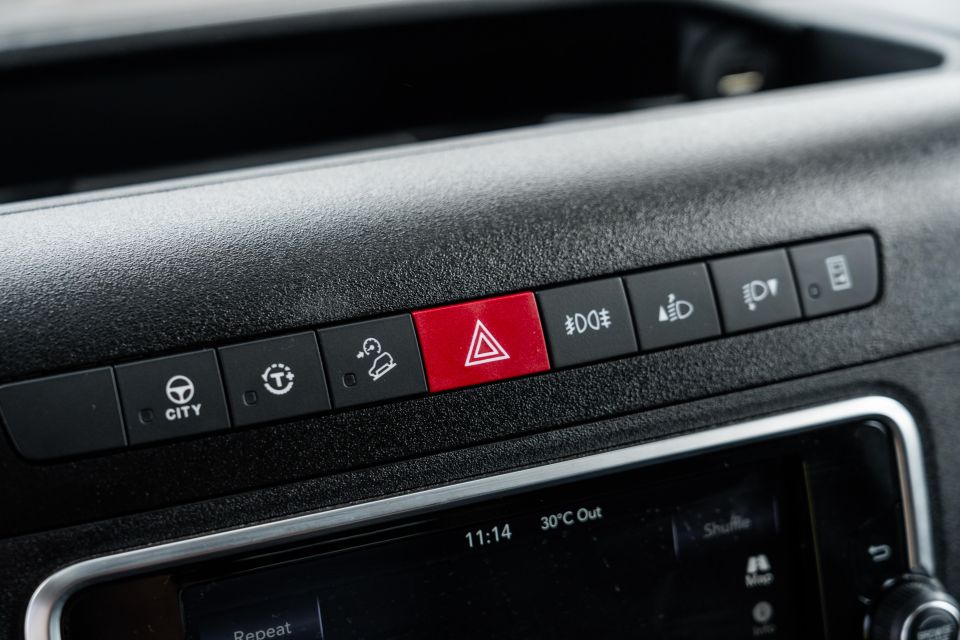
Standard safety equipment on the E6 Van range includes:
The optional Hi-Technology Pack adds:
The 2024 Iveco Daily E6 Van is covered by a three-year, 250,000km warranty. An extended warranty that covers the vehicle for up to five years/300,000km is available at an extra cost.

Logbook servicing is required every 12 months or 50,000km, whichever comes first. Yes, you read that correctly, every 50,000km.
Iveco Australia offers three-, four- and five-year service packages for the Daily E6. The most comprehensive version of these service packages is called Easy Road and costs $6300 for three years, $13,050 for four years, and $18,850 for five years.
The Iveco Daily E6 Van is a really interesting and extremely capable vehicle that fills a niche for many fleet customers, though seemingly gets overlooked as an option for private buyers.
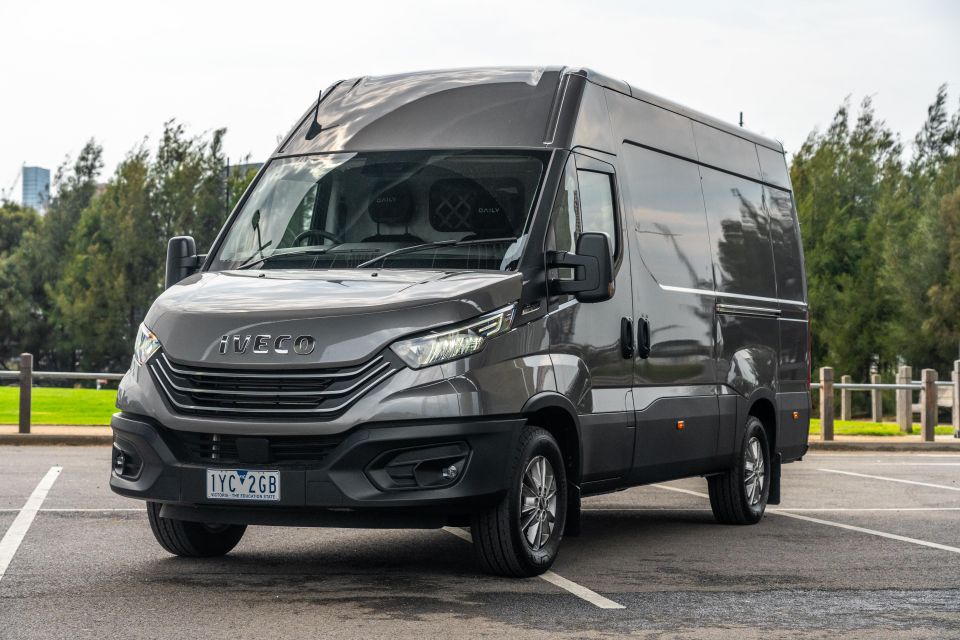
This might be put down partially to the price of the Daily as it’s more expensive than virtually all of its van competitors.
What makes this kind of vehicle unique is it’s ability to be loaded up all the way to the maximum payload figure, and then still legally be able to tow a 3.5-tonne braked trailer. Virtually no dual-cab ute is capable of doing this.
The typical van box body style on test here won’t necessarily win over every single buyer in Australia, though don’t forget Iveco also offers a dual-cab-chassis version of the Daily.
Even better there’s a 4×4 version of the Daily if that tickles your fancy. Once you start heading in this heavy-duty direction however you start reaching the upper echelons of what you can legally drive on a regular car licence.
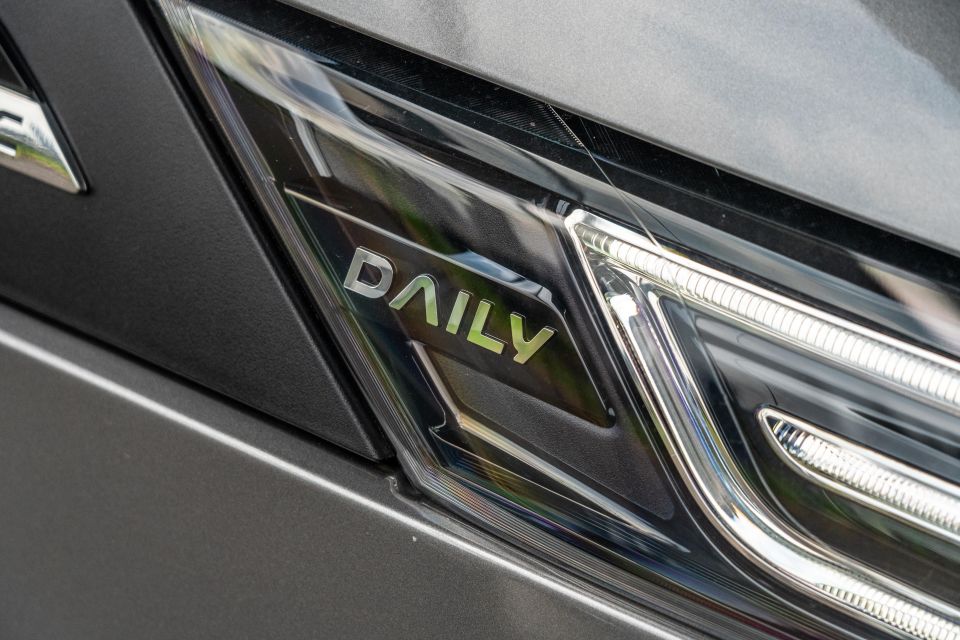
Click the images for the full gallery
BUY: Iveco Daily MORE: Everything Iveco Daily
Where expert car reviews meet expert car buying – CarExpert gives you trusted advice, personalised service and real savings on your next new car.
Jack Quick is an automotive journalist based in Melbourne. Jack studied journalism and photography at Deakin University in Burwood, and previously represented the university in dance nationally. In his spare time, he loves to pump Charli XCX and play a bit of Grand Theft Auto. He’s also the proud owner of a blue, manual 2020 Suzuki Jimny.


CarExpert.com.au
4 Days Ago
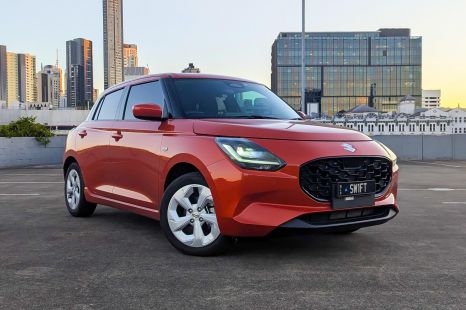

William Stopford
4 Days Ago


Max Davies
3 Days Ago


Josh Nevett
2 Days Ago


Andrew Maclean
1 Day Ago


Shane O'Donoghue
21 Hours Ago